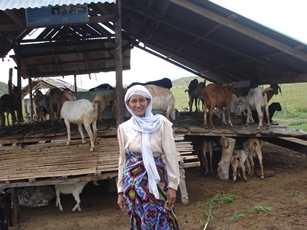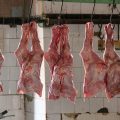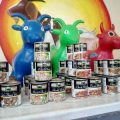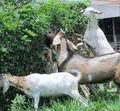The goat industry in the Philippines is considered a sunrise industry dominated by backyard raisers, but slowly becoming popular among commercial investors. In January 2015, it stands at a meager 3.67 million head, dropping by 0.58% from previous year’s production. In fact, the inventory has been decreasing annually since 2010.
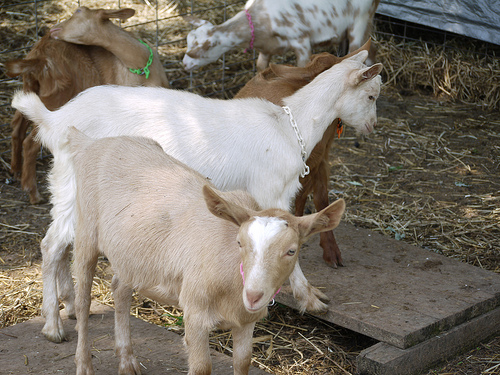
The country’s small goat population can be attributed to two basic factors–high slaughter rate and low productivity. Low productivity stems from the farmers’ limited knowledge on improved management practices and lack of access to quality breeders. This leads to long production cycles of more than 9 months and low conception rate of only 75% for the dam and high preweaning mortality rate (25%) and low slaughter weight (15kg) for the kids.
The low supply of goat’s meat amid its high demand, reveals goat production’s enormous potential, especially as consumers’ preferences shift to healthy options worldwide. Goat’s meat is known to be lower in saturated fat than chicken, pork and beef, low in cholesterol, but higher in protein.
Goat production requires lower investment with a high rate of return. There is also high promise in producing authentic halal goat, a niche that Muslim Mindanao can embark on, considering the requirement of our Muslim brothers within and outside the country.
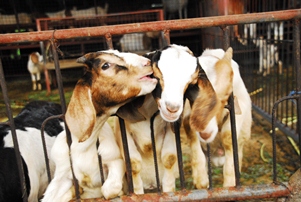
Slaughter Goat ISP accomplishments
The GOAT Industry Strategic S&T Program (ISP) is an attempt to address the gaps and potentials of the country’s goat industry in a holistic way. To improve goat productivity and enhance goat-based enterprises, the Program introduced science-based interventions on feeding, breeding, health, and farm recording. Three modalities developed by the Philippine Council for Agriculture, Aquatic and Natural Resources Research and Development of the Department of Science and Technology (DOST-PCAARRD) help bring these technologies to geographically dispersed raisers: the Farmer Livestock School on Goat Enterprise Management (FLS-GEM), the e-learning courses on goat, and the artificial insemination (AI) delivery system.
As of Dec 2015, 2003 farmers of the targeted 2400 have been trained in Regions 1, 2, 3, 8, 10, 12, and CAR on improved goat production using the Program-developed modality, the FLS-GEM, a six-month long farm-based training for farmers.
Seen as an effective modality, the FLS-GEM has been embraced by no less than the private sector-led Federation of Goat and Sheep Producers and Associations of the Philippines, Inc (FGASPAPI) as its national training modality for goat production. The association requires farmers to undergo this training before any goat from the government is dispersed to them.
Raisers with access to the Internet who cannot be accommodated in the FLS were encouraged to enrol in the online goat courses available at www.e-extension.gov.ph/elearning.
The training for FLS beneficiaries on breeding and proper feeding of does, addressed the problem of low dam performance. As of November 2015, conception rate has increased from 75% to 87%. This exceeds the target of 81% for 2015.
Kidding interval (KI) was also shortened from 9 months to 8 months, thereby increasing kidding index from 1.35 to 1.52 kiddings/doe per year. With the promotion of proper feeding, housing, and health regimen for does and kids, preweaning mortality also significantly dropped from 25% to 4.5%.
Hadja Horon Ngilay, halal goat farmer from General Santos City, is one of the cooperators for the PCAARRD project on the establishment of standard practices on halal goat production and quality assurance (Photo from the Livestock Research Division, DOST-PCAARRD)
To address the farmers’ lack of access to breeder bucks, the Program introduced artificial insemination (AI) using semen from exotic breeds. It also refined the protocol on goat AI and enhanced the semen extender mixture, Semex. This protocol was later institutionalized with the Unified National AI Program of the Dept. of Agriculture, which formerly catered only to cattle and carabao.
As of November 2015, 214 technicians, 485 farmers, and 81 entrepreneurs have been trained on any of the required trainings: AI service provision; basic reproductive physiology and AI administration; or AI business aspects. Because of these, 1,765 does (out of 2700 targeted does) were inseminated in the six regions producing 875 additional kids. The infusion of quality genetic materials in these smallholder farms thru AI, led to the increase in average birth weight by 43% (1.5 -2.25kg) and slaughter weight by 80% (15kg to 27kg).
Despite the success of the FLS and the AI delivery system in the six participating regions, there are still gaps on feeding, breeding and health that R&D needs to address. Since high mortalities of kids have been traced to the poor nutritional plane and disorders of the does before, during and after kidding, feeding interventions initially focused on the doe. Forage strata gardens were established, tested, and promoted. These gardens do not only serve as sources of planting materials but also as regular feed for the does. At the moment, they are being converted into different variants of flush feeds for the does in the form of leaf meals and pelletized rations.
Forage compactors have also been developed to ease storage of legume-grass hay for lean season feeding. An herbal dewormer composed of Makahiya-Caimito-Makabuhay has also been completed and is awaiting commercialization by drug manufacturers. This dewormer will address the current resistance of goat parasites to commercial dewormers.
Aside from conditioning the doe prior to kidding, giving of preweaner supplements also helps increase kid survival. As there are currently no locally made feed products specifically for goat, several products were developed and tested. These included a cocowater-based drench supplement for newborn kids and three creep feed formulations to help bridge the gap from liquid (milk) to solid (forage) feeding.
The long production cycle of does was observed to be mainly due to seasonality of breeding (usually occurring from September to February) and lack of access of does to bucks. To stimulate estrus and induce off-season breeding among does, three non-invasive heat induction techniques have been tested and will soon be promoted in the FLS and the online courses.
Optimistic that the industry will attain an increase in goat population and volume over time, the Program developed two Philippine National Standards: the Code of Hygienic Slaughtering for Goat and Chevon Cuts. These publications contain the protocols on goat slaughtering and cutting that have been standardized by ISU in collaboration with the Bureau of Agriculture and Fisheries Standards (BAFS). With these standards the industry can expect better slaughtering and cuts and can therefore institute the right pricing scheme.
Likewise to add value to the products and ensure that nothing goes to waste after slaughtering, the Program developed and applied for patent nine chevon-based products from prime cuts, bones and meat trimmings. It also fabricated a bouillon dehydrator. Currently, the food products are either completing their shelf life studies or undergoing product labeling at the Industrial Technology Development Institute of the Department of Science and Technology (ITDI-DOST), and they will soon be registered with the National Meat Inspection Service (NMIS) prior to commercialization.
Aware of the potential of producing halal goat products, the Program developed and tested halal assurance protocols on goat production, transport and marketing, slaughtering, processing, and lab-based haram detection. These protocols identified the critical control points where haram contamination occurs and the correct practice to address these.
These are currently being developed into Philippine National Standards (PNS) with BAFS, NMIS, halal certification boards, and the National Commission on Muslim Filipinos (NCMF). Along with these protocols, 3 halal-compliant chevon-based food products (chevon jerky or tapa, sweet- cured chevon or tocino, shredded corned chevon) have been developed and are awaiting commercialization.
To promote these protocols and products, a Farmer Livestock School on Halal Goat Enterprise Management is being developed using the original FLS-GEM as take-off point.
DOST-PCAARRD will showcase Slaughter Goat ISP technologies including other science and technology (S&T) outputs on March 2-4, 2016 during the SIPAG FIESTA at its headquarters in Los Baños, Laguna.
SIPAG, a technology transfer strategy, embodies the Council’s commitment to DOST’s Outcome One in a bid to ensure that the fruits of R&D activities for the agri-aqua sectors will be a blessing for every Juan.
by Livestock Research Division, DOST-PCAARRD S&T Media Service
